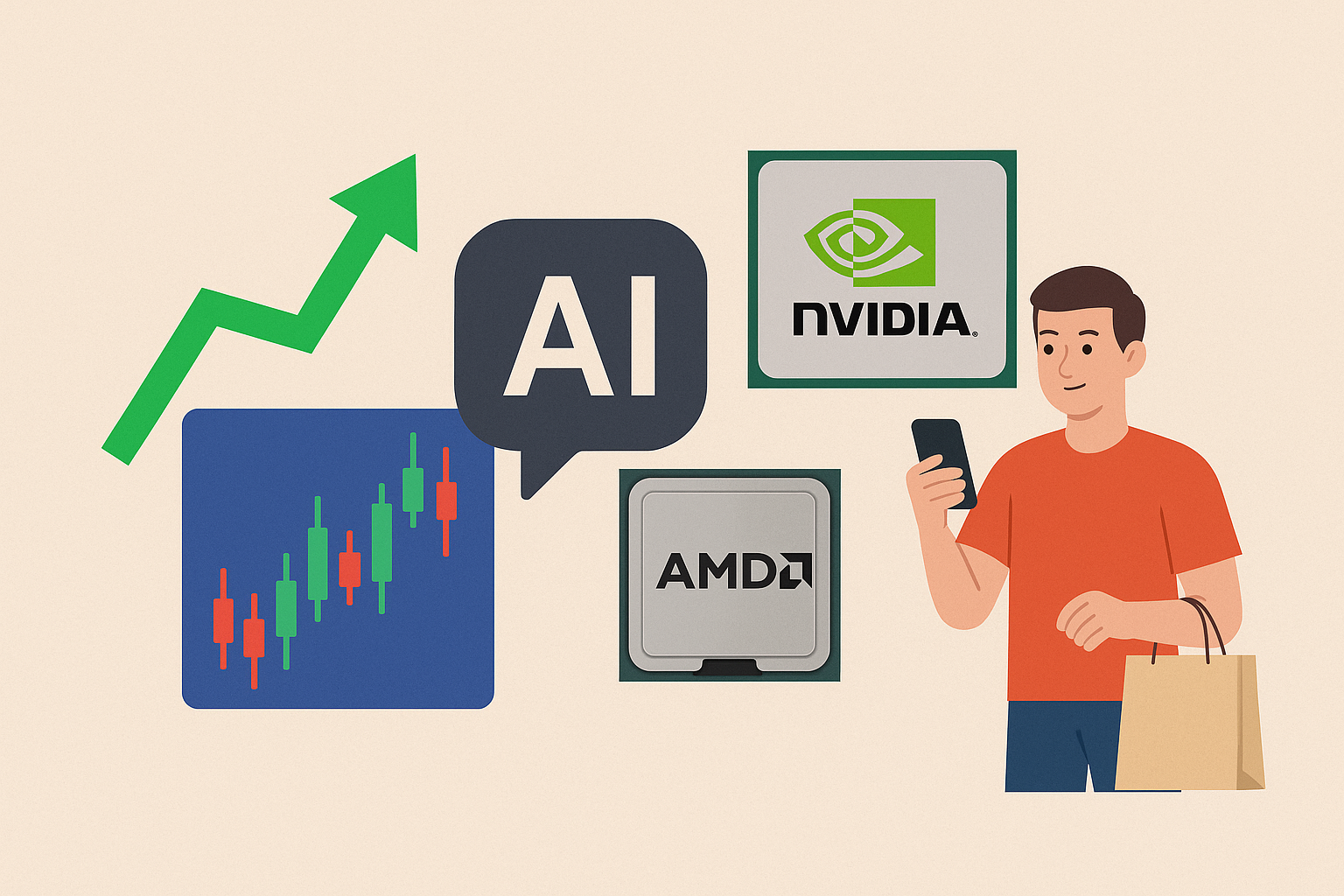Introduction
The stock market has entered a new era, and retail investors are once again at the forefront of change. In 2025, artificial intelligence (AI) is not just a buzzword—it’s a primary driver of technological advancement, corporate strategy, and now, retail investing. Amid this landscape, AI stocks such as Nvidia and AMD have become key targets for non-institutional investors, who are fueling a powerful shift in trading dynamics. This article delves deep into why AI equities have captured the imagination of retail traders, how market behavior is evolving, and what it means for the future of investing.
The Rise Of Retail Investors
Retail investors have gained significant influence over the past few years. Following the COVID-19 pandemic and the rise of commission-free trading platforms like Robinhood, a new wave of investors entered the market. Armed with mobile apps, online forums, and social media platforms, these individuals began executing trades with a confidence that once seemed exclusive to professional traders.
What started with meme stocks like GameStop and AMC has evolved into more sophisticated territory. Retail investors are no longer just chasing hype—they are conducting due diligence, analyzing industry trends, and increasingly focusing on high-growth sectors such as artificial intelligence.
Why AI? The Technology Of The Future
Artificial Intelligence is seen by many as the foundational technology of the next few decades. From autonomous vehicles and personalized healthcare to intelligent data analytics and machine learning, AI’s potential is vast. This excitement isn’t limited to academics or tech leaders—investors are also keenly aware of the profit potential.
AI-related companies are experiencing massive valuation increases, not solely based on future speculation but also on real, measurable performance. Nvidia, for example, has become the backbone of AI processing, thanks to its high-performance GPUs that power everything from ChatGPT to Tesla’s self-driving systems. AMD, while slightly behind Nvidia in AI-specific branding, has also pushed aggressively into AI-capable hardware with its new chip architecture and advanced data center offerings.
Nvidia: The Market Leader In AI Chips
Nvidia has emerged as the face of AI infrastructure. In early 2025, the company reported quarterly earnings that beat analyst expectations, driven by record-breaking sales in its data center segment. The explosive growth in AI model training and inferencing created unprecedented demand for Nvidia’s H100 and H200 GPUs.
For retail investors, Nvidia is a dream stock—high growth, real earnings, and a strong brand narrative. Its valuation has reached historic highs, and despite concerns of a tech bubble, many investors believe this is just the beginning.
Key Investor Drivers:
- Belief in long-term AI adoption.
- Confidence in Nvidia’s technological leadership.
- Repeated earnings outperformance.
- Strong institutional buy-in reinforcing retail confidence.
AMD: The Underdog With Potential
While Nvidia dominates headlines, AMD has quietly built a formidable position in the AI space. Its MI300 series accelerators are gaining traction, and the company is investing heavily in partnerships and ecosystem development.
Retail investors view AMD as a lower-cost entry into the AI market. For those priced out of Nvidia’s soaring stock, AMD offers both affordability and upside potential. Its diverse portfolio in gaming, CPU development, and enterprise applications makes it a balanced pick for medium- to long-term holders.
Key Investment Appeal
- Attractive valuation relative to Nvidia.
- Growing data center presence.
- Cross-industry exposure including gaming and cloud computing.
AI Stocks And The Evolution Of Retail Strategy
Retail investors today are smarter and more strategic. They’re using tools like TradingView for technical analysis, reading earnings reports, and following regulatory developments. AI stocks, with their high news flow and earnings volatility, are particularly attractive to this cohort.
Unlike traditional buy-and-hold strategies, many retail traders are implementing hybrid models—buying core positions in AI leaders while swing trading around earnings events or major product announcements.
Common Strategies Observed
Earnings momentum trading: Buying ahead of earnings releases based on guidance and analyst sentiment.
Sector rotation: Moving funds into AI as broader tech gains slow.
Thematic ETF exposure: Investing in AI-centric ETFs like Global X Robotics & Artificial Intelligence ETF (BOTZ) for diversified exposure.
Retail Vs. Institutional: Blurring The Lines
One of the most interesting shifts in 2025 is how retail investing is beginning to mirror institutional behavior. While the average retail trader may not have access to algorithmic systems or massive research departments, the gap is closing fast due to democratized financial data and AI-assisted research tools.
Platforms like FinChat, EarningsWhispers, and even GPT-powered investment analysis tools now enable everyday investors to parse complex data with minimal friction. As a result, the “dumb money” label often assigned to retail investors is being actively challenged.
The Role Of Social Media And AI In Decision-Making
Retail sentiment is often shaped by narratives shared across platforms like X (formerly Twitter), Reddit, and YouTube. Influencers who can explain earnings reports, speculate on chip shipments, or dissect product launches in real time wield significant power over market movements.
AI plays a dual role here—it’s not only the subject of investment but also the enabler. AI-powered bots now provide sentiment analysis, chart pattern recognition, and even auto-generate financial summaries that aid retail investors in decision-making.
Risks And Volatility: A Double-Edged Sword
While AI stocks offer explosive growth, they are also subject to extreme volatility. Nvidia’s shares, for example, have swung by as much as 10% in a single day post-earnings. This can be devastating for poorly timed trades or over-leveraged positions.
Moreover, the high correlation between major AI stocks means that a single negative headline—such as regulatory clampdowns, chip bans, or manufacturing delays—can trigger sector-wide selloffs.
Retail investors are becoming increasingly aware of these risks, and many now utilize options for hedging or engage in portfolio diversification strategies to mitigate drawdowns.
Regulatory Outlook And Its Impact On Retail Investors
As AI becomes more embedded in economic and societal structures, regulatory scrutiny will intensify. From data privacy to AI model accountability, governments are beginning to draft legislation that could directly impact companies like Nvidia and AMD.
Retail investors must consider how regulation could shape revenue streams, increase R&D costs, or alter international sales pipelines. For example, U.S.-China tensions and export bans on high-end chips have already forced Nvidia to revise its growth projections in specific regions.
What’s Next For AI Stocks?
The consensus among market analysts is that AI is a long-term growth story, but not without near-term hurdles. Valuations for stocks like Nvidia are high, and investor expectations are lofty. Any earnings miss or guidance cut could lead to sharp corrections.
That said, the broader macro trend is favorable. From government investment in AI infrastructure to private sector adoption in finance, manufacturing, and healthcare, demand for AI computing power is unlikely to wane. This continued momentum is expected to keep retail investor interest strong well into the decade.
Tips For Retail Investors Navigating The AI Boom
Do Your Research: Understand not just what the company does, but how it fits into the AI ecosystem.
Monitor Earnings Closely: Earnings seasons are often when AI stocks move the most.
Don’t Chase Hype: Enter trades with a defined risk/reward ratio.
Use Dollar-Cost Averaging: Spread out your investment to reduce timing risks.
Stay Updated on Regulations: Follow news around chip bans, AI legislation, and macroeconomic shifts.
Conclusion
The rise of AI stocks has introduced a new chapter in retail investing. What began with curiosity has transformed into a sustained trend where everyday investors are betting big on the technology of the future. Companies like Nvidia and AMD are not just tech leaders—they are now cultural icons within retail investment circles.
As more people seek financial autonomy through stock market participation, the retail crowd’s focus on AI underscores a broader theme: today’s investors are more informed, more strategic, and more influential than ever before.
While the road ahead may feature volatility and occasional setbacks, the convergence of technology, investing tools, and investor enthusiasm makes this one of the most compelling narratives in modern market history.

